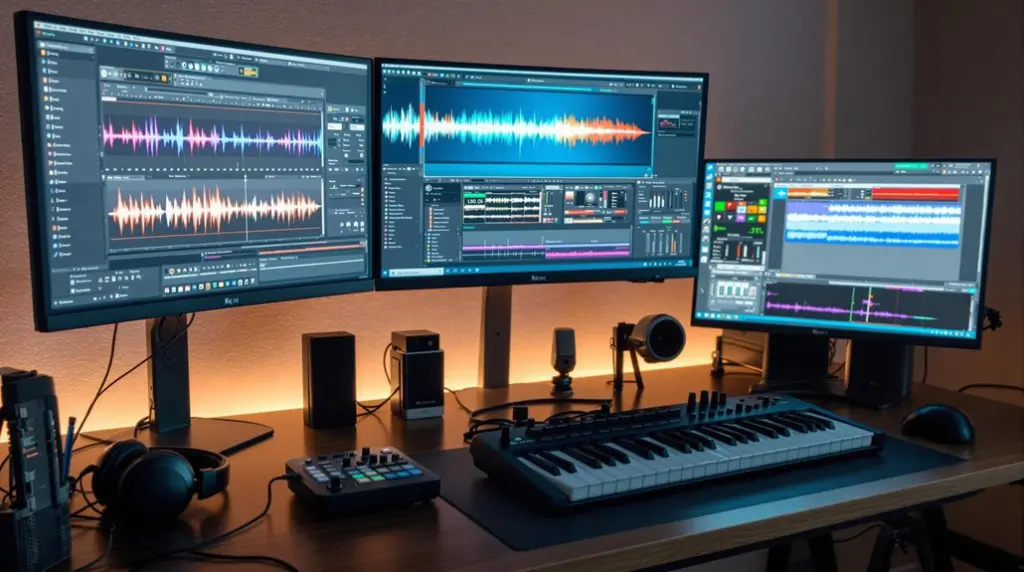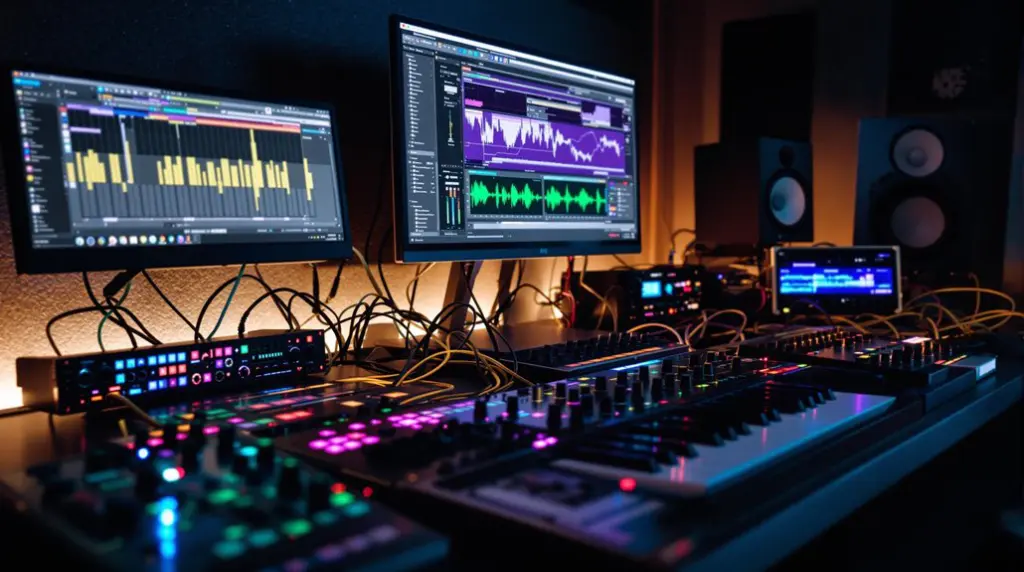The Korg Prologue excels with its sophisticated hybrid sound engine, integrating analogue and digital elements across 16 voices, offering versatile sound generation through its VCOs and Multi Engine oscillator. Its modulation and effects capabilities are impressive, with resonant 12dB/octave filters, a flexible LFO, and high-quality stereo effects including reverb and delay. The build quality stands out with a robust aluminum and wood construction, an intuitive interface, and a full-sized keyboard designed for expressiveness. These features make it perfect for both studio and live environments. Discover how these elements come together to enhance the musician’s experience.
Key Takeaways
- Hybrid sound engine with 16 voices, combining analogue VCOs and a versatile digital Multi Engine oscillator.
- High-quality modulation and effects processing, including 12 distinct delays and 10 reverbs with 32-bit floating-point precision.
- Intuitive user interface featuring a robust black aluminum front panel and oak wood side panels for aesthetics and durability.
- Full-sized, velocity-sensitive keyboard designed for expressive playability and real-time OLED display for waveform visualization.
- Portable design weighing approximately 10kg, ideal for touring musicians without compromising on sound quality.
Sound Generation and Oscillator Features
The Korg Prologue stands out in the crowded field of synthesizers due to its sophisticated sound generation and oscillator capabilities. Featuring a hybrid sound engine with 16 voices, it seamlessly combines analogue and digital elements to offer unparalleled oscillator versatility.
Each voice integrates two analogue VCOs and a digital Multi Engine oscillator, enabling a rich palette of sound design possibilities. The Multi Engine is particularly remarkable, supporting three distinct modes: Noise, VPM (Variable Phase Modulation, akin to FM synthesis), and user-defined oscillators. This functionality allows users to craft diverse waveforms that transcend traditional analog sounds, broadening the scope of hybrid synthesis.
The analogue VCOs further enhance this versatility with dedicated knobs for distortion and fine-tuning pitch, thereby allowing musicians to sculpt rich textures and unique timbres. Additionally, the Prologue’s design addresses voicing inconsistencies, which lend character to otherwise static waveshapes.
The integration of advanced separation algorithms guarantees that each voice maintains clarity, even in complex compositions. This feature opens new avenues for innovative sound combinations, making it particularly suited for contemporary music genres.
With a total of 32 VCOs and 16 digital oscillators, the Prologue is capable of generating a vast array of distinctive sounds, establishing itself as a versatile tool in any sound designer’s arsenal.
Modulation and Effects Processing
Korg Prologue’s modulation and effects processing capabilities enhance its status in the domain of high-end synthesizers. Central to its sound-shaping prowess are its filter characteristics, featuring a resonant 12dB/octave low-pass filter and a high-pass filter. These filters come with adjustable cutoff, resonance, and bipolar contour amount, allowing for extensive and nuanced sound sculpting.
The filter cutoff modulation, with its quarter-tone quantization, guarantees precise adjustments, vital for sound designers seeking detailed control. This precision is akin to the frequency analysis tools used in mastering to rectify imbalances, making the Prologue a powerful tool in sound design.
The Prologue’s LFO capabilities are equally impressive, offering a single LFO per voice with three selectable modes: slow, fast, and BPM. This LFO supports adjustable frequency and depth, though it is limited to modulating one destination at a time. Despite this, the LFO provides ample modulation flexibility, enhancing the dynamic range of the synth’s tones.
Complementing its modulation features, the Prologue excels in effects processing. It includes two stereo digital effects sections: one for modulation effects such as choruses, ensembles, phasers, and flangers, and another dedicated to delay and reverb.
With 12 distinct delays and 10 reverbs, all utilizing 32-bit floating-point processing, the Prologue delivers rich, high-quality soundscapes, adding depth and complexity to its synthesized tones.
User Interface and Build Quality
Building upon the Prologue‘s exceptional modulation and effects processing, its user interface and build quality further solidify its position as a premium synthesizer. The Prologue boasts a robust black aluminum front panel paired with oak wood side panels, which considerably enhance both its aesthetic appeal and durability. This sophisticated design language not only captivates the eye but also guarantees the instrument can withstand rigorous use in various settings.
Additionally, the intuitive design of the Prologue makes it highly accessible for both beginners and seasoned professionals.
Central to the user experience is the full-sized, velocity-sensitive keyboard. This keyboard is meticulously designed for high expressiveness and playability, making it an ideal choice for both studio and live performance environments. The user-friendly interface simplifies parameter adjustments, allowing musicians to focus more on creativity and less on technicalities.
The OLED display is a standout feature, providing real-time visualization of sound waveforms, which is essential for intricate sound design. With internal memory capable of storing 500 patches—250 factory presets and 250 INIT sounds—navigation is seamless, especially during performances.
Despite its extensive features, the Prologue remains portable, weighing approximately 10kg, making it a practical choice for touring musicians who refuse to compromise on quality. This combination of thoughtful design and robust construction guarantees an unparalleled user experience.
Frequently Asked Questions
What Is the Most Famous Korg?
The Korg M1 is arguably the most famous Korg synthesizer, epitomizing the Korg legacy and innovations with its iconic sounds and samples that shaped late ’80s and early ’90s music, setting a benchmark in the industry.
Does the Korg Prologue Have a Sequencer?
No, the Korg Prologue does not feature internal sequencer capabilities. Instead, it relies on its bi-timbral architecture and versatile arpeggiator for rhythmic elements, necessitating external MIDI sequencers or DAW software for complex music production and composition.
Does Korg Prologue Have Aftertouch?
The Korg Prologue does not feature aftertouch functionality. However, it compensates through its pitch and modulation wheels, and expression pedal integration, ensuring robust synthesizer expression capabilities for dynamic and expressive performance techniques.
What Key Size Is Korg Prologue?
The Korg Prologue features full-sized keys, ensuring a professional key action and superior build quality. This design caters to both stage and studio settings, providing musicians with a responsive and dynamic playing experience.
Conclusion
The Korg Prologue synthesizer excels in sound generation and oscillator capabilities, offering a robust range of sonic possibilities. Its modulation and effects processing further enhance its versatility, providing depth and texture to the audio output. The user interface and build quality are meticulously designed, ensuring intuitive navigation and durability. These features collectively establish the Prologue as a powerful and reliable instrument, suitable for both professional and creative musical endeavors.




